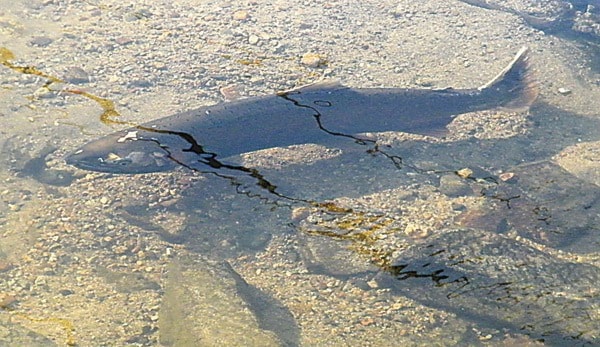They’re probably right under your nose, and you don’t even know it, hanging out near the shopping mall or auto shop, biding their time a few metres from the backyard and a lawnmower as they build size and strength for their trip to the ocean.
If it wasn’t for the tiny, hidden creeks, fed by groundwater or springs so they’re resilient to summer heat and droughts, coho wouldn’t be around.
“They’re the urban salmon, they really are,” says Ross Davies, with the Kanaka Environmental and Educational Society.
Unlike the famous sockeye which blitz up the Fraser River to points far into the B.C. Interior, and recently to the upper reaches of the Alouette River system, the coho like to stay local and hang around for an extra year after hatching, instead of making a run for the ocean in their first year, as do the chum or pinks.
“Of all the Lower Mainland salmonid species, they are the most dependent on fresh water,” Davies says of coho.
Sometimes the role of those trickles of water, maybe just the equivalent of three taps running, is hard to grasp.
People moving out from the big city, even long-time residents are surprised when they learn the channel or ditch near their property is home to juvenile coho.
“Throw in a minnow trap, we say, ‘Look at this’ – and they can’t believe it,” says Davies.
He recently posted a coho on the KEEPS FaceBook, page showing a good-sized coho in the main stem of Kanaka Creek, one of several that indicate the coho run is healthy this year. The size of the Kanaka system coho run can vary between 200 and 300, or go up to 4,000.
Last July, when water temperatures in Kanaka Creek hit 24 or 25 C, “those juvenile coho were just packing into side streams looking for cooler water.”
Davies wants property owners and the public to know that most streams or ditches or rivulets are either fish habitat or leads to it.
He delivers a similar message to the school kids when he delivers outdoor programs.
“The small little streams produce fish like crazy. They are very, very untidy [streams], not manicured to the edge … fallen root wads … little hiding places.”
We still get landowners who think streams have to be cleaned, to help the fish, Davies said. “When the opposite is true.”
One example of a coho stream that runs almost in homeowners backyards is Lower Rainbow Creek, which flows into Kanaka Creek, off Kanaka Way.
Another coho creek is a tributary in the 207th Street area near Lougheed Highway. The tributary flows into McKenny Creek which runs past Ridge Meadows Hospital.
Seigle, Salamander, Cottonwood and Horseshoe creeks all the play same role in providing miniature nurseries for salmon fry up to 10 centimetres in size.
Coho have even made it to the upper reaches of Millionaire Creek, as far as UBC Research Forest, adds Geoff Clayton with the Alouette River Management Society. “They’re very aggressive little devils and they love those streams.”
But in addition to their natural predators, the coho now have to deal with invasive species such as carp, perch or bass that people have dumped into streams. The quiet waters of the Pitt Poulder and Alouette River systems “are crowded with these invasive species.”
Clayton though can remember when coho were so plentiful in the Coquitlam River, you could almost walk across them. People used to haul them out by the bucket load from English Bay, he adds.
Still, he credits the District of Maple Ridge with at least trying to protect the streams with its stream protection rules.
On the other hand, the district continues to expand its suburbs which eats into more fish habitat.
Davies points out that 80 per cent of the coho from south of Hope has been lost over the last century, by a thousand cuts, often because of land development that either covered up streams or starved them by eating into the streamside area cutting their water sources.
On the other hand, thanks to rehabilitation, salmon streams in Burnaby are 40 per cent more productive compared to 40 years ago.
“We’re going to get them back the same way – just one stream at a time – one metre at a time.
“Obviously we’re at the mercy of climate change and marine conditions but at least we can keep care of our end of things and make the fresh-water habitat as good as we can.”
